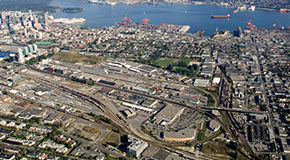Vancouver Park Board
Media Advisory
November 28, 2017
November 28, 2017
The Bright Nights Christmas Train is on track for another holiday season.
This year the train—a holiday tradition for many families in the Lower Mainland—is celebrating the 20 year partnership between
the Vancouver Park Board and the
BC Professional Fire Fighters’ Burn Fund.
The attraction features displays with more than three million lights, train decorations, entertainment, and Santa Claus.
A quarter of a million people enjoy this seasonal attraction each year.
Media are invited to learn more:
When: Wednesday, November 29, 5 - 9 pm with
speeches at 7 pm
Where: Stanley Park train, off Pipeline
Road in Stanley Park
Who: Vancouver Park Board Deputy General
Manager Shauna Wilton, BC Professional Fire Fighters’ Burn Fund Vice President Ray Boucher, and burn survivors
What: Launch of Bright Nights Christmas
Train and VIP opening night
More than 600 professional fire fighters from across the Lower Mainland donate 8,000 hours of their time to help set up and take down the displays and lights at the Bright Nights Christmas Train.
More than 600 professional fire fighters from across the Lower Mainland donate 8,000 hours of their time to help set up and take down the displays and lights at the Bright Nights Christmas Train.
The matinee and evening Bright Nights train runs from Thursday, November 30 until
Saturday, January 6, 2018. Hours of operation vary. It is closed Christmas Day.
Advance tickets are available at ticketleader.ca
or by calling at 604-252-3700. Same-day tickets are available at the
Stanley Park Railway Plaza starting at 10 am daily. A portion of each
day’s tickets is set aside for on-site sells.
Special live shows and visuals will be performed by Mortal Coil Performance Society.
Bright Nights is the Burn Fund’s signature fundraising event with $2.5 million raised to date. Donations in bins at the front gate and partial proceeds from train admissions support the BC Professional Fire Fighters’ Burn Fund. The Burn Fund provides lifesaving, life supporting, and life enriching services to the people in British Columbia.
The Bright Nights Christmas Train also accepts donations for the Greater Vancouver Food Bank.
- 30 –
|
|
Media contact:
Vancouver Park Board
604.257.8440




